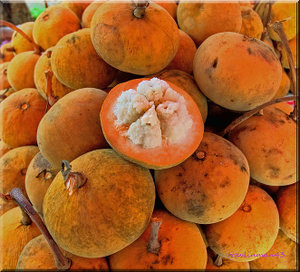Advertisement
Published: August 23rd 2011

 Santol Fruit
Santol Fruit
The fruit is native to a few Southeast Asian countries. Northern Philippines includes the Ilocos Region : Ilocos Norte with its capital in Laoag City, and Ilocos Sur with its capital in the historic town of Vigan. Locals are collectively called Ilocanos or Ilokanos. And their cuisine is distinctly Ilocano in that it represents and integrates in every dish the major Ilocano trait of frugality and industry.
Vegetarian Delights: Sinigang na Malaga, Dinengdeng, Poqui-Poqui, Pinakbet
Malaga is a kind of fish. In Vigan's Kusina Felecitas Restaurant in Grandpa's Inn, it is cooked in broth soured by a tropical fruit,
santol which is native to a few southeast asian countries like the Philippines, Thailand, Malaysia and Borneo. Called
Sinigang na Malaga (Fish Cooked In Sour Broth), this sour soupy dish is garnished with vegetables such as stringbeans and kangkong, our local water spinach.
Just like it, there is also the
Dinengdeng but without the sour broth. Dinengdeng is another soupy dish seasoned with the local fish or shrimp paste, thus rendering it a bit salty. Another authentic Ilocano dish of cut up vegetables like
malunggay(our local horseradish leaves) or its fruit boiled in watery soup, seasoned with
bagoong and sometimes topped with grilled fish.
Poqui-Poqui is roasted

 Sinigang na Malaga
Sinigang na Malaga
Malaga is a kind of fish. Sinigang is a sour broth. This is fish cooked in a sour broth using a local fruit called santol.eggplant cooked with eggs, garnished with tomatoes and onions. It can be eaten alone, or as a side dish to grilled meat or fish dishes.
Among these Ilocano vegetable dishes, I'd have to say that it is the
Pinakbet which has acquired a "national" stature. Pinakbet or Pakbet, has had quite a number of versions as the dish was adopted by other regions and soon became a favorite vegetable dish. As it "evolved", the other versions of Pinakbet added other vegetables like squash to the original set of eggplant, bitter gourd, okra, stringbeans and squash flowers. Like the Dinengdeng, it is also seasoned with fermented fish paste called "bagoong".
And how about some shellfish? I have not tried this anywhere else, but we were pleasantly surprised to find
Kulintipay Shells in the menu at
Kusina Felecitas in Vigan's Grandpa's Inn. Tastes just like clams. The shells are used to make window panes and frames, more commonly known as
capiz shells. Many old houses used capiz shells framed in wood as their sliding windows.
And There's Something For The Carnivores Too!
Ilocos is famous for its
longganiza, in particular the Vigan Longganiza. We
have these local sausages in almost every place around the Philippines, varying in sizes and in how garlicky the sausages are. The type you find here are very, very garlicky. In the Philippines, a typical breakfast includes longganiza and garlic fried rice. It is also the kind of breakfast item which is available anytime of day in many eating places. I learned from past experience not to bring home these sausages on a 10 hour drive back to Manila. Not unless you don't mind having that garlicky aroma on your dress, and on your hair! By the time we reached Manila then, everyone we've met somehow knew where we came from and what we've brought home without asking. 😊
For the serious meat or pork lovers, there is the
bagnet. Chunks of pork belly boiled and then twice deep-fried to a crisp, typically served with tomatoes, onions and the local
bagoong or fermented fish paste.
Warek Warek is not for everyone. Are you ready for this? Ingredients include pig’s meat and entrails (tongue, liver, intestine). First time I tried it, I thought it was like the "Kilawin" or our local ceviche. But not so. The
entrails are parboiled with
calamansi, our local lemon, and then grilled and sliced into strips. Before serving like a salad, the dish is seasoned with the juice of the local lemon (calamansi), salt, and pepper.
If you 'survived' Warek Warek, then maybe you would want to try the Crispy
Dinardaraan. In other parts of the country, it is simply called
Dinuguan. Again, we are talking innards here, but stewed in pig's blood. Does this now sound like an episode in Fear Factor? 😊 But I'm telling ya, the locals love their dinuguan. Especially the crispy version from Ilocos. Find it all in
La Preciosa Restaurant in Laoag.
Fusion Cuisine and Some Snack Food
In
Herencia Cafe, one can order the Pinakbet Pizza. I have to admit I couldn't imagine this before we actually tried it, but we were certainly not disappointed.
Empanadas are what we call our local pies. Yes, that's also Spanish for pies. It must be a recipe passed on from generation to generation since the Spaniards ruled the land. There is a place in the plaza near the Vigan Church where you can watch how these empanadas are made. I
have to warn you though that these snack food is as oily as you get it. Imagine crushed longganizas on a bed of eggs, carrots and cabbages, rolled/wrapped in the flour mixture and then deep fried. Best eaten soon after frying, while the empanadas are crispy. And oily!
If we had more days to spend, and more meals to eat, we would have ordered the other Ilocano special dishes like
Higadu (more innards.....) ,
Insarabasab, Duyduy, and Inabraw. Perhaps next time!
Advertisement
Tot: 0.087s; Tpl: 0.011s; cc: 13; qc: 34; dbt: 0.0386s; 1; m:domysql w:travelblog (10.17.0.13); sld: 2;
; mem: 1.2mb

























D MJ Binkley
Dave and Merry Jo Binkley
Wow, wow, wow!
Love the food tripping. Amazing photography. I would love to sample these.